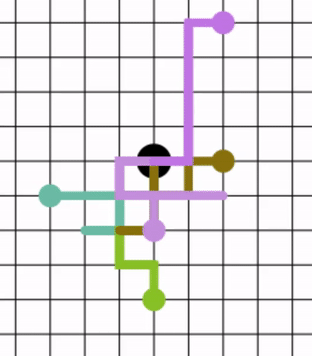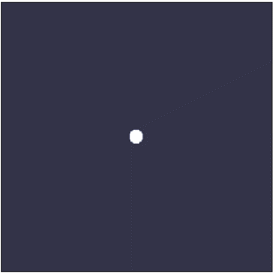|
Diffusion Limited Aggregation
Diffusion-limited aggregation (DLA) is the process whereby particles undergoing a random walk due to Brownian motion cluster together to form aggregates of such particles. This theory, proposed by T.A. Witten Jr. and L.M. Sander in 1981, is applicable to aggregation in any system where diffusion is the primary means of transport in the system. DLA can be observed in many systems such as electrodeposition, Hele-Shaw flow, mineral deposits, and dielectric breakdown. The clusters formed in DLA processes are referred to as Brownian trees. These clusters are an example of a fractal. In 2D these fractals exhibit a dimension of approximately 1.71 for free particles that are unrestricted by a lattice, however computer simulation of DLA on a lattice will change the fractal dimension slightly for a DLA in the same embedding dimension. Some variations are also observed depending on the geometry of the growth, whether it be from a single point radially outward or from a plane or line f ... [...More Info...] [...Related Items...] OR: [Wikipedia] [Google] [Baidu] |
Random Walk
In mathematics, a random walk is a random process that describes a path that consists of a succession of random steps on some mathematical space. An elementary example of a random walk is the random walk on the integer number line \mathbb Z which starts at 0, and at each step moves +1 or −1 with equal probability. Other examples include the path traced by a molecule as it travels in a liquid or a gas (see Brownian motion), the search path of a foraging animal, or the price of a fluctuating stock and the financial status of a gambler. Random walks have applications to engineering and many scientific fields including ecology, psychology, computer science, physics, chemistry, biology, economics, and sociology. The term ''random walk'' was first introduced by Karl Pearson in 1905. Lattice random walk A popular random walk model is that of a random walk on a regular lattice, where at each step the location jumps to another site according to some probability distribution. In a ... [...More Info...] [...Related Items...] OR: [Wikipedia] [Google] [Baidu] |
Dendrite (crystal)
A crystal dendrite is a crystal that develops with a typical multi-branching form. The name comes from the Greek word dendron (δενδρον) which means "tree", since the crystal's structure resembles that of a tree. These crystals can be synthesised by using a supercooled pure liquid, however they are also quite common in nature. The most common crystals in nature exhibit dendritic growth are snowflakes and frost on windows, but many minerals and metals can also be found in dendritic structures. History Maximum velocity principle The first dendritic patterns were discovered in palaeontology and are often mistaken for fossils because of their appearance. The first theory for the creation of these patterns was published by Nash and Glicksman in 1974, they used a very mathematical method and derived a non-linear integro-differential equation for a classical needle growth. However they only found an inaccurate numerical solution close to the tip of the needle and they f ... [...More Info...] [...Related Items...] OR: [Wikipedia] [Google] [Baidu] |
Fractal Canopy
In geometry, a fractal canopy, a type of fractal tree, is one of the easiest-to-create types of fractals. Each canopy is created by splitting a line segment into two smaller segments at the end (symmetric binary tree), and then splitting the two smaller segments as well, and so on, infinitely.Bello, Ignacio; Kaul, Anton; and Britton, Jack R. (2013). ''Topics in Contemporary Mathematics'', p.511. Cengage Learning. . Canopies are distinguished by the angle between concurrent adjacent segments and ratio between lengths of successive segments. A fractal canopy must have the following three properties: #The angle between any two neighboring line segments is the same throughout the fractal. #The ratio of lengths of any two consecutive line segments is constant. #Points all the way at the end of the smallest line segments are interconnected, which is to say the entire figure is a Graph (discrete mathematics)#Connected graph, connected graph. The pulmonary system used by humans to breat ... [...More Info...] [...Related Items...] OR: [Wikipedia] [Google] [Baidu] |
Eden Growth Model
The Eden growth model describes the growth of specific types of clusters such as bacterial colonies and deposition of materials. These clusters grow by random accumulation of material on their boundary. These are also an example of a surface fractal. The model, named after Murray Eden, was first described in 1961 as a way of studying biological growth, and was simulated on a computer for clusters up to about 32,000 cells. By the mid-1980s, clusters with a billion cells had been grown, and a slight anisotropy had been observed. See also * Diffusion-limited aggregation Diffusion-limited aggregation (DLA) is the process whereby particles undergoing a random walk due to Brownian motion cluster together to form aggregates of such particles. This theory, proposed by T.A. Witten Jr. and L.M. Sander in 1981, is app ... References Bacteriology {{fractal-stub ... [...More Info...] [...Related Items...] OR: [Wikipedia] [Google] [Baidu] |
Dielectric Breakdown Model
Dielectric breakdown model (DBM) is a macroscopic mathematical model combining the diffusion-limited aggregation model with electric field. It was developed by Niemeyer, Pietronero, and Weismann in 1984. It describes the patterns of dielectric breakdown of solids, liquids, and even gases, explaining the formation of the branching, self-similar Lichtenberg figures. See also * Eden growth model * Lichtenberg figure * Diffusion-limited aggregation Diffusion-limited aggregation (DLA) is the process whereby particles undergoing a random walk due to Brownian motion cluster together to form aggregates of such particles. This theory, proposed by T.A. Witten Jr. and L.M. Sander in 1981, is app ... References External links Dielectric Breakdown Model Electricity Mathematical modeling Electrical breakdown {{electric-stub ... [...More Info...] [...Related Items...] OR: [Wikipedia] [Google] [Baidu] |
Java Programming Language
Java is a high-level, class-based, object-oriented programming language that is designed to have as few implementation dependencies as possible. It is a general-purpose programming language intended to let programmers ''write once, run anywhere'' ( WORA), meaning that compiled Java code can run on all platforms that support Java without the need to recompile. Java applications are typically compiled to bytecode that can run on any Java virtual machine (JVM) regardless of the underlying computer architecture. The syntax of Java is similar to C and C++, but has fewer low-level facilities than either of them. The Java runtime provides dynamic capabilities (such as reflection and runtime code modification) that are typically not available in traditional compiled languages. , Java was one of the most popular programming languages in use according to GitHub, particularly for client–server web applications, with a reported 9 million developers. Java was originally developed ... [...More Info...] [...Related Items...] OR: [Wikipedia] [Google] [Baidu] |
Open Source
Open source is source code that is made freely available for possible modification and redistribution. Products include permission to use the source code, design documents, or content of the product. The open-source model is a decentralized software development model that encourages open collaboration. A main principle of open-source software development is peer production, with products such as source code, blueprints, and documentation freely available to the public. The open-source movement in software began as a response to the limitations of proprietary code. The model is used for projects such as in open-source appropriate technology, and open-source drug discovery. Open source promotes universal access via an open-source or free license to a product's design or blueprint, and universal redistribution of that design or blueprint. Before the phrase ''open source'' became widely adopted, developers and producers have used a variety of other terms. ''Open source'' gained ... [...More Info...] [...Related Items...] OR: [Wikipedia] [Google] [Baidu] |
Point Cloud
Point or points may refer to: Places * Point, Lewis, a peninsula in the Outer Hebrides, Scotland * Point, Texas, a city in Rains County, Texas, United States * Point, the NE tip and a ferry terminal of Lismore, Inner Hebrides, Scotland * Points, West Virginia, an unincorporated community in the United States Business and finance *Point (loyalty program), a type of virtual currency in common use among mercantile loyalty programs, globally *Point (mortgage), a percentage sometimes referred to as a form of pre-paid interest used to reduce interest rates in a mortgage loan * Basis point, 1/100 of one percent, denoted ''bp'', ''bps'', and ''‱'' * Percentage points, used to measure a change in percentage absolutely * Pivot point (technical analysis), a price level of significance in analysis of a financial market that is used as a predictive indicator of market movement * "Points", the term for profit sharing in the American film industry, where creatives involved in making the fil ... [...More Info...] [...Related Items...] OR: [Wikipedia] [Google] [Baidu] |
Sunflow
Sunflow is an open-source global illumination rendering system written in Java Java (; id, Jawa, ; jv, ꦗꦮ; su, ) is one of the Greater Sunda Islands in Indonesia. It is bordered by the Indian Ocean to the south and the Java Sea to the north. With a population of 151.6 million people, Java is the world's mos .... The project is currently inactive; the last announcement on the program's official page was made in 2007. References External links Sunflow Rendering System website Sunflow ForumSunflow documentation wiki 3D rendering software for Linux Computer-aided design software for Linux Cross-platform software Free 3D graphics software Free computer-aided design software Free software programmed in Java (programming language) Global illumination software {{graphics-software-stub ... [...More Info...] [...Related Items...] OR: [Wikipedia] [Google] [Baidu] |
Lichtenberg Figure
A Lichtenberg figure (German ''Lichtenberg-Figuren''), or Lichtenberg dust figure, is a branching electric discharge that sometimes appears on the surface or in the interior of insulating materials. Lichtenberg figures are often associated with the progressive deterioration of high voltage components and equipment. The study of planar Lichtenberg figures along insulating surfaces and 3D electrical trees within insulating materials often provides engineers with valuable insights for improving the long-term reliability of high-voltage equipment. Lichtenberg figures are now known to occur on or within solids, liquids, and gases during electrical breakdown. Lichtenberg figures are natural phenomena which exhibit fractal properties. History Lichtenberg figures are named after the German physicist Georg Christoph Lichtenberg, who originally discovered and studied them. When they were first discovered, it was thought that their characteristic shapes might help to reveal the nature ... [...More Info...] [...Related Items...] OR: [Wikipedia] [Google] [Baidu] |
Scientific American
''Scientific American'', informally abbreviated ''SciAm'' or sometimes ''SA'', is an American popular science magazine. Many famous scientists, including Albert Einstein and Nikola Tesla, have contributed articles to it. In print since 1845, it is the oldest continuously published magazine in the United States. ''Scientific American'' is owned by Springer Nature, which in turn is a subsidiary of Holtzbrinck Publishing Group. History ''Scientific American'' was founded by inventor and publisher Rufus Porter (painter), Rufus Porter in 1845 as a four-page weekly newspaper. The first issue of the large format newspaper was released August 28, 1845. Throughout its early years, much emphasis was placed on reports of what was going on at the United States Patent and Trademark Office, U.S. Patent Office. It also reported on a broad range of inventions including perpetual motion machines, an 1860 device for buoying vessels by Abraham Lincoln, and the universal joint which now can be found ... [...More Info...] [...Related Items...] OR: [Wikipedia] [Google] [Baidu] |



